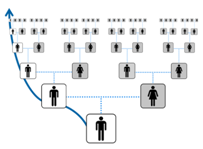 |
In contrast to the comparison tests above, which compare the DNA between two individuals to confirm their maternal or paternal relatedness, our Ancestry DNA tests examine your DNA to find out where your ancestors came from thousands of years ago. |
Unlock the secrets hidden inside your DNA!Find out more about yourself and your family through our unique DNA test.
Our Ancestry DNA test has been used in many situations:
Your DNA might contain information you haven't considered while researching your family tree Order a Test Today to find out what you've been missing!
Why not do a paternal lineage test to learn more about your ancient paternal roots and your forefathers many millennia ago ? With our test you can trace your paternal ancestry, the origins of your paternal ancestors and their migration patterns..
Your direct paternal lineage is the line that follows your father’s paternal ancestry. This line consists entirely of men.

YY-DNA follows the direct paternal line. Your Y-chromosome DNA (Y-DNA) can trace your father, his father, his father’s father, and so forth. It offers a clear path from you to a known, or likely, direct paternal ancestor.
With our maternal lineage test, you can choose to specifically locate the origins of your maternal ancestors. Learn where your maternal ancestors settled as well as the migration patterns of your forebearers out of Africa to the rest of the globe.
Your direct maternal lineage is the line that follows your mother’s maternal ancestry. This line consists entirely of women, although both men and women have their mother’s mitochondrial DNA (mtDNA). This means that fathers do not pass on their mtDNA to their children. Your mtDNA can trace your mother, her mother, her mother’s mother, and so forth and offers a clear path from you to a known or likely direct maternal ancestor.
Note that you and your matches may share ancestors on other parts of your family tree; however, those matches are coincidence.
Your mtDNA may help you find genetic cousins along your direct maternal line. When we look at your mtDNA results, we look for differences in your mtDNA caused by small changes — copying errors — that are called mutations* or polymorphisms. We compare those differences to the differences of other people in our database. The range of possible generations before you share a common ancestor with a match is wide. Your mtDNA exact matches may be recent, but they may also be hundreds or thousands of years in the past. We show this in the following table.
Begin unravelling your ancestry with our DNA test. Discover your ancestry and get a generalized picture of your ancestry from a unique genetic perspective. Our ancestral origins test will link your DNA to geographical regions and studied anthropological groups. Results ready in 2 weeks from receipt of samples.
Our ancestral origins DNA test is just what you need if you wish to learn more about your deep ancestral roots. Yes, this test will in fact link you to that remote part of your genealogical pre-history. Our ancestry DNA test is a cutting edge service we offer for those wishing to dig deeper into their origins. We will provide you with an easy-to-use at home DNA sample collection kit. Your results will be sent to you by email in 2-3 weeks starting from the time we get your samples.
Your DNA might contain information you haven't considered while researching your family tree Order a Test Today to find out what you've been missing
| Marketing | : | joe@advanceddna.in |
| Laboratory | : | lab@advanceddna.in |
| Enquiry | : | advanceddna08@gmail.com |